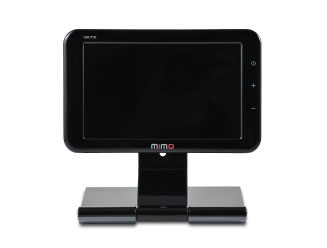Nanovision Mimo 7" USB Powered LCD Monitors
The Mimo UM-710 monitor is only about 0.8-inches thick, and measures 7.7x4.8-inches (HxD). The Mimo-740 is only a few millimeters thicker (but still well under 1-inch thick) and it is also a hair taller and deeper at 7.75x5.0-inches. Both monitors come with removable stands that attach to the back of the displays. The stands can lean the monitors forward and backward, but doing so beyond a fairly limited range will cause the top-heavy design to either topple forward or backward. By loosening the mounting screw on the back of the stand, the monitors can be pivoted into either landscape or portrait mode (note: that you have to manually change the display settings in software in order for the image on the display to be properly oriented). With the monitors oriented vertically, the top of the viewable area of the displays is about 9.3-inches up from the surface the stands are resting on.
    |
|
Nanovision Mimo UM-710 |
    |
|
Nanovision Mimo UM-740 |






